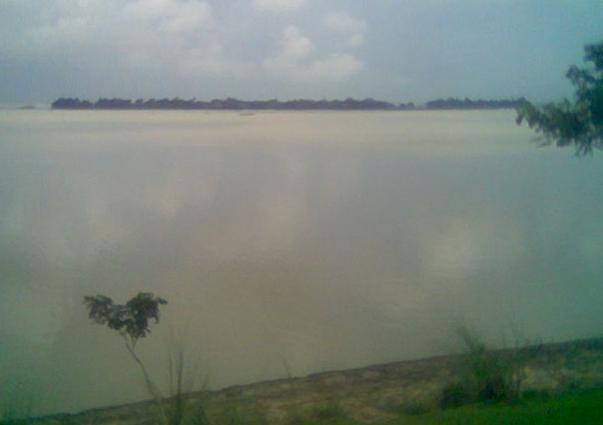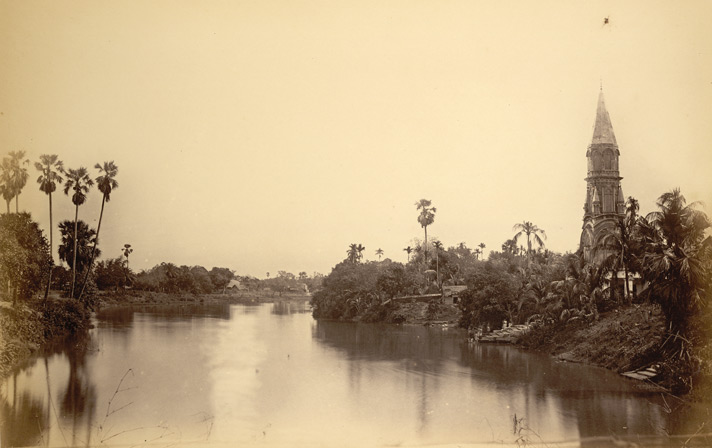|
Ruknuddin Barbak Shah
Ruknuddīn Bārbak Shāh ( bn, রোকনউদ্দীন বারবক শাহ, fa, ; r. 1459–1474) was the son and successor of Sultan Nasiruddin Mahmud Shah. Initially appointed as the governor of Satgaon during the reign of his father, Barbak ascended the throne of the Bengal Sultanate in 1459. He was the first ruler to give prominent roles in the Sultanate's administration to the Abyssinian community. Historian Aniruddha Ray credits Barbak Shah as the pioneer of urbanisation in Bengal. Early life and ascension Barbak was born into an aristocratic Bengali Muslim Sunni family known as the Ilyas Shahi dynasty that had founded the Bengal Sultanate in 1352 CE. Despite his family's long presence in the region, Barbak's ancestors were of Sistani origin, hailing from what is now eastern Iran and southern Afghanistan. His father, Sultan Nasiruddin Mahmud Shah, ruled Bengal for over twenty years. During his father's reign, Barbak served as the Governor of Satgaon (Ars ... [...More Info...] [...Related Items...] OR: [Wikipedia] [Google] [Baidu] |
Sultan Of Bengal
The Sultanate of Bengal (Middle Bengali language, Middle Bengali: শাহী বাঙ্গালা ''Shahī Baṅgala'', Classical Persian: ''Saltanat-e-Bangālah'') was an empire based in Bengal for much of the 14th, 15th and 16th centuries. It was the dominant power of the Ganges–Brahmaputra Delta, with a network of mint towns spread across the region. The Bengal Sultanate had a circle of vassal states, including Odisha in the southwest, Arakan in the southeast, and Tripura in the east. Its raids and conquests reached Nepal in the north, Assam in the east, and Jaunpur Sultanate, Jaunpur and Varanasi in the west. The Bengal Sultanate controlled large parts of the north, east and northeast Indian subcontinent during its five dynastic periods, reaching its peak under Hussain Shahi dynasty. It was reputed as a thriving trading nation and one of Asia's strongest states. Its decline began with an interregnum by the Suri Empire, followed by Mughal Empire, Mughal Bengal Subah, ... [...More Info...] [...Related Items...] OR: [Wikipedia] [Google] [Baidu] |
Afghanistan
Afghanistan, officially the Islamic Emirate of Afghanistan,; prs, امارت اسلامی افغانستان is a landlocked country located at the crossroads of Central Asia and South Asia. Referred to as the Heart of Asia, it is bordered by Pakistan to the Durand Line, east and south, Iran to the Afghanistan–Iran border, west, Turkmenistan to the Afghanistan–Turkmenistan border, northwest, Uzbekistan to the Afghanistan–Uzbekistan border, north, Tajikistan to the Afghanistan–Tajikistan border, northeast, and China to the Afghanistan–China border, northeast and east. Occupying of land, the country is predominantly mountainous with plains Afghan Turkestan, in the north and Sistan Basin, the southwest, which are separated by the Hindu Kush mountain range. , Demographics of Afghanistan, its population is 40.2 million (officially estimated to be 32.9 million), composed mostly of ethnic Pashtuns, Tajiks, Hazaras, and Uzbeks. Kabul is the country's largest city and ser ... [...More Info...] [...Related Items...] OR: [Wikipedia] [Google] [Baidu] |
Dhaka Division
Dhaka Division ( bn, ঢাকা বিভাগ, ''Ḑhaka Bibhag'') is an administrative division within Bangladesh. Dhaka serves as the capital city of the Dhaka Division, the Dhaka District and Bangladesh. The division remains a population magnet, covers an area of 20,508.8 km2 with a population in excess of 44 million, growing at 1.94% rate since prior count, compared with national average of 1.22%. However, national figures may include data skewing expatriation of male labor force as gender ratio is skewed towards females. Dhaka Division borders every other division in the country except Rangpur Division. It is bounded by Mymensingh Division to the north, Barisal Division to the south, Chittagong Division to the east and south-east, Sylhet Division to the north-east, and Rajshahi Division to the west and Khulna Divisions to the south-west. Administrative divisions Dhaka Division consisted before 2015 of four city corporations, 13 districts, 123 upazilas and 1,248 ... [...More Info...] [...Related Items...] OR: [Wikipedia] [Google] [Baidu] |
Chittagong Division
Chittagong Division, officially known as Chattogram Division, is geographically the largest of the eight administrative divisions of Bangladesh. It covers the south-easternmost areas of the country, with a total area of and a population at the 2011 census of 28,423,019. The administrative division includes mainland Chittagong District, neighbouring districts and the Chittagong Hill Tracts. Chittagong Division is home to Cox's Bazar, the longest natural sea beach in the world; as well as St. Martin's Island, Bangladesh's sole coral reef. History The Chittagong Division was established in 1829 to serve as an administrative headquarters for five of Bengal's easternmost districts, with the Chittagong District serving as its headquarters. During the East Pakistan period, the division's Tippera district was renamed to Comilla District in 1960. In 1984, fifteen districts were created by separating and reducing the original five districts of Chittagong, Comilla, Hill Tracts, Noakhal ... [...More Info...] [...Related Items...] OR: [Wikipedia] [Google] [Baidu] |
Rangpur Division
Rangpur Division ( bn, রংপুর বিভাগ) is one of the Divisions in Bangladesh. It was formed on 25 January 2010, as Bangladesh's 7th division. Before that, it was under Rajshahi Division. The Rangpur division consists of eight districts. There are 58 Upazilas or subdistricts under these eight districts. Rangpur is the northernmost division of Bangladesh and has a population of 15,665,000 in the 2011 Census. The major cities of this new division are Rangpur, Saidpur and Dinajpur. Rangpur has well-known educational institutions, such as Carmichael College, Hajee Mohammad Danesh Science and Technology University, Rangpur Medical College, Rangpur Cadet College, Begum Rokeya University and Bangladesh Army University of Science and Technology, Saidpur. Mansingh, commander of Emperor Akbar, conquered part of Rangpur in 1575. Rangpur came completely under the Mughal empire in 1686. Mughalbasa and Mughalhat of Kurigram district still bear marks of the Mughal rule in ... [...More Info...] [...Related Items...] OR: [Wikipedia] [Google] [Baidu] |
Rajshahi Division
Rajshahi Division ( bn, রাজশাহী বিভাগ) is one of the eight first-level administrative divisions of Bangladesh. It has an area of and a population at the 2011 Census of 18,484,858. Rajshahi Division consists of 8 districts, 70 Upazilas (the next lower administrative tier) and 1,092 Unions (the lowest administrative tier). The region has historically been dominated by various feudal Rajas, Maharajas and Zamindars. Formerly comprising 16 districts, a new division (Rangpur Division) was formed with the 8 northern districts of the old Rajshahi Division from early 2010. Etymology and names The Rajshahi Division is named after Rajshahi District. Dominated by various feudal Rajas, Maharajas and Zamindars of mixed origins throughout history, the name is a compound of the words ''Raj'' and ''Shahi'', both of which can be translated into reign or kingdom. Archaic spellings in the English language also included ''Rajeshae''. The capital city of the division was for ... [...More Info...] [...Related Items...] OR: [Wikipedia] [Google] [Baidu] |
Malda Division
Malda Division is an administrative division within the Indian state of West Bengal. This division build on 22 Nov 2016.This division was earlier a part of Jalpaiguri division and was carved out from it in 2016. The headquarters and the largest city of the Malda Division is Malda. The office of divisional commissioner is temporary located in old circuit house at B. G. Road, Malda. Districts It consists of 4 districts: Demographics Malda division is the only division of West Bengal where Muslims forms the dominant group of the population. Muslims comprises 60.94% of the population whereas Hindus Hindus (; ) are people who religiously adhere to Hinduism. Jeffery D. Long (2007), A Vision for Hinduism, IB Tauris, , pages 35–37 Historically, the term has also been used as a geographical, cultural, and later religious identifier for ... form 38.20% of the population. [...More Info...] [...Related Items...] OR: [Wikipedia] [Google] [Baidu] |
Jame Mosque
A congregational mosque or Friday mosque (, ''masjid jāmi‘'', or simply: , ''jāmi‘''; ), or sometimes great mosque or grand mosque (, ''jāmi‘ kabir''; ), is a mosque for hosting the Friday noon prayers known as ''Friday prayer, jumu'ah''.* * * * * * * * * It can also host the Eid prayers in situations when there is no ''musalla'' or ''eidgah'' available nearby to host the prayers. In early History of Islam, Islamic history, the number of congregational mosques in one city was strictly limited. As cities and populations grew over time, it became more common for many mosques to host Friday prayers in the same area. Etymology The full Arabic term for this kind of mosque is ''masjid jāmi‘'' (), which is typically translated as "mosque of congregation" or "congregational mosque". "Congregational" is used to translate ''jāmi‘'' (), which comes from the Arabic Semitic root, root "ج - م - ع" which has a meaning ‘to bring together’ or ‘to unify’ (verbal form: an ... [...More Info...] [...Related Items...] OR: [Wikipedia] [Google] [Baidu] |
Chittagong
Chittagong ( /ˈtʃɪt əˌɡɒŋ/ ''chit-uh-gong''; ctg, চিটাং; bn, চিটাগং), officially Chattogram ( bn, চট্টগ্রাম), is the second-largest city in Bangladesh after Dhaka and third largest city in Bengal region. It is the administrative seat of the eponymous division and district. It hosts the busiest seaport on the Bay of Bengal. The city is located on the banks of the Karnaphuli River between the Chittagong Hill Tracts and the Bay of Bengal. The Greater Chittagong Area had a population of more than 5.2 million in 2022. In 2020, the city area had a population of more than 3.9 million. One of the world's oldest ports with a functional natural harbor for centuries, Chittagong appeared on ancient Greek and Roman maps, including on Ptolemy's world map. It was located on the southern branch of the Silk Road. In the 9th century, merchants from the Abbasid Caliphate established a trading post in Chittagong. The port fell to the Muslim co ... [...More Info...] [...Related Items...] OR: [Wikipedia] [Google] [Baidu] |
Buriganga
The Buriganga River ( bn, বুড়িগঙ্গা, ''Buŗigônga'', ) is a river in Bangladesh which flows past the southwest outskirts of the capital city, Dhaka. Its average depth is and its maximum depth is . It ranks among the most polluted rivers in the country. Dhaleshwari River According to R. C. Majumdar, in the distant past, it is probable that a course of the Ganges river used to reach the Bay of Bengal through the Dhaleshwari River. The Buriganga originated from the Dhaleshwari in the south of Savar, near Dhaka In the 20th century the water table and river became polluted by polythenes and other hazardous substances from demolished buildings near the river banks. Pollution The Buriganga is economically very important to Dhaka. Launches and country boats provide connection to other parts of Bangladesh, a largely riverine country. When the Mughals made Dhaka their capital in 1610, the banks of the Buriganga were already a prime location for trade. The rive ... [...More Info...] [...Related Items...] OR: [Wikipedia] [Google] [Baidu] |
Mint (facility)
A mint is an industrial facility which manufactures coins that can be used as currency. The history of mints correlates closely with the history of coins. In the beginning, hammered coinage or cast coinage were the chief means of coin minting, with resulting production runs numbering as little as the hundreds or thousands. In modern mints, coin dies are manufactured in large numbers and planchets are made into milled coins by the billions. With the mass production of currency, the production cost is weighed when minting coins. For example, it costs the United States Mint much less than 25 cents to make a quarter (a 25 cent coin), and the difference in production cost and face value (called seigniorage) helps fund the minting body. Conversely, a U.S. penny ($0.01) cost $0.015 to make in 2016. History The first minted coins The earliest metallic money did not consist of coins, but of unminted metal in the form of rings and other ornaments or of weapons, which were used for th ... [...More Info...] [...Related Items...] OR: [Wikipedia] [Google] [Baidu] |




.jpg)


